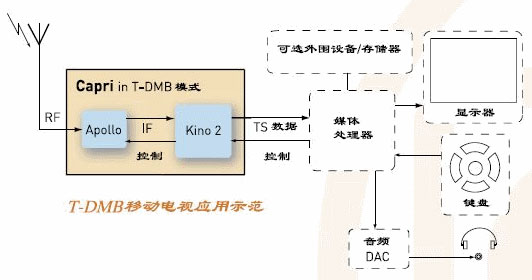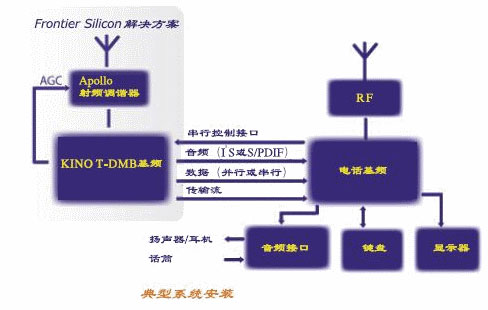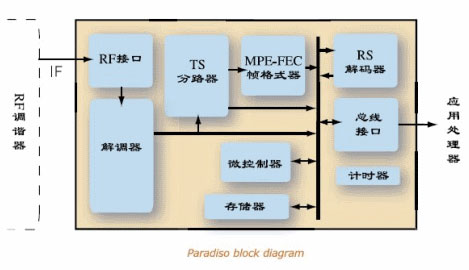With the successful launch of T-DMB mobile digital TV business services at the end of last year, the commercial viability of mobile digital TV is beyond doubt. The advent of mobile digital TV allows anyone to watch digital TV programs being broadcast in real time anywhere the satellite/terrestrial radio tower can cover, whether he is on the road or in a moving car. Spectacular scenes of people's alleys will go into history in major sports or political events.
This article refers to the address: http://
Currently, mobile phones with mobile digital TV reception are very popular in Korea, and the retail market is based on a shortage of supply. The global market prospects for such portable devices are also expected to be very good, as the market demand for global mobile digital TV receivers in 2006 was only 10 million units, according to an evaluation report conducted by Credit Suisse in January this year. By 2009, this demand will grow rapidly to 150 million units.
Although mobile digital TV has just entered the vision of government, industry and consumers, it has quickly become a killer application for portable devices and has become the main driving force for the development of related electronics industries in all major regions of the world. However, the criteria adopted by regions based on national business and strategic interests are also different. For example, Europe first developed the mobile standard DVB-H based on its commercial terrestrial fixed digital TV transmission standard DVB-T. Currently, Germany and the UK have decided to adopt the European standard DVB-H, but Germany hopes to launch before the World Cup in June this year. Mobile digital TV commercial services, while DVB-H not only has too few content providers, but also has high deployment costs. Therefore, Germany will first adopt the T-DMB standard for commercial operation to provide mobile digital TV commercial services to football fans. The United States and Japan decided to adopt the MediaFLO and ISDB-T standards based on national interest considerations. South Korea decided to adopt the T-DMB standard and entered the commercial operation at the end of last year.
The 11th Five-Year Plan of the Chinese government has emphasized support for mobile digital TV services and actively promoted mobile digital TV to provide quality commercial services for the 2008 Olympic Games. The Ministry of Broadcasting and Television has also made mobile digital TV a hot market development for the next five years, China. The development of mobile digital TV has been set up. However, although China is currently actively developing its own standard MMB (Mobile Multimedia Broadcasting) or DMB-T, it still cannot see a complete prototype, so it is estimated that mobile will be introduced first with mature DVB-H and T-DMB standards. Digital TV commercial services.
At present, China's radio and television department has started trial operation of mobile digital TV based on T-DMB standard in Beijing, Shanghai and Guangzhou, and its multimedia content development companies (such as Beijing Yuelong Digital Broadcasting, Shanghai Oriental Pearl Group, Guangdong Mobile TV Media Company and Guangdong TV Station has also begun to actively develop content, and it is expected that in June this year, it will take the lead in small-scale commercial operations in these cities. Although there are also suppliers doing DVB-H testing in China, the scale is much smaller than that of T-DMB. Secondly, there is no support for the content of the Ministry of Radio and Television. Therefore, China is expected to first adopt the T-DMB standard.
“Commercial T-DMB services will be available in the Chinese market earlier than the European digital mobile TV standard DVB-H,†said SK Tay, general manager of Frontier Silicon Hong Kong Ltd. “This will make it possible for China to enter T- DMB export market.†Frontier Silicon is discussing cooperation with major mobile phone manufacturers in China and is currently in the final stage of project discussions, he revealed.
Under the current market landscape, multi-standard/multi-band solutions are naturally the most popular for portable device manufacturers interested in expanding their target markets to more countries. Zheng Xiangjia pointed out: "Multi-band is the demand of the market yesterday. Multi-standard is the market demand today. In 2008, with the increase in the volume of portable devices with mobile digital TV reception, the market will pay more attention to mass production. Miniaturized/optimized solution."
Mobility and convenience are making consumers more and more accustomed to using portable devices, Zheng Xiangjia said, according to a recent market research company, even at home, about 30% of people are more willing to watch on portable devices. Digital Television.
If this figure represents a certain general consumption habit, it means that the market for mobile digital TV in the future will be much larger than the current fixed digital TV market, because in the future, mobile digital TV will appear in almost all portable consumer electronics. Equipment (such as mobile phones, portable multimedia players, laptops, digital cameras, portable DVD players and high-end gaming terminals), car navigation systems and audio-visual entertainment systems, and even today's elevators and public consumption sites are hanging on flat-panel advertising machines.

Analysis of advantages and disadvantages of T-DMB and DVB-H standards
The T-DMB standard uses the Band 3 and L bands, and the DVB-H uses the UHF band. These two mature standards each have their own advantages and disadvantages. “The biggest advantages of T-DMB compared with DVB-H include: the earliest commercial operation; the broadcast frequency is much lower than the UHF frequency used by DVB-H, so the required transmit power is also small; the deployment cost is lower. Only a small number of towers are needed to cover a large area, so the cost of infrastructure construction is only 10% of DVB-H.†Zheng Xiangjia pointed out that “the biggest shortcoming may be the supported digital programs.†There are not many channels, generally 4 to 8, and the maximum audio, video and data decoding rate is only 1.8 Mbps, while DVB-H can support dozens of channels with a maximum decoding rate of 33 Mbps."
The future of the DVB-H standard in the Chinese market may be that it can provide consumers with more programming channels because it can create more revenue sources for operators and content providers, and consumers like to see more. Rich programs. However, Alex Sin, director of business development at Frontier Silicon Hong Kong Ltd., believes that the market should accept both standards. He said: "T-DMB has a first-mover advantage, and in general, the channels that consumers like to watch are usually less than five."
However, there are currently fewer chipset vendors supporting T-DMB, mainly Frontier Silicon and some IC suppliers in Israel/Korea. Almost all established IC suppliers only support DVB-H, such as TI, Freescale, Philips, DiBcom and Microtune. Of course, with the introduction of the latest DVB-H/T-DMB/DAB multi-standard baseband chip Paradiso, Frontier Silicon now also provides support for DVB-H.
From the power point of view, the current T-DMB tuner has the lowest power consumption. For example, Frontier Silicon's tri-band dual-mode (T-DMB/DAB) RF front-end receiver Apollo FS1110 consumes less than 80mW, while Freescale's Frodo Zero The IF DVB-H tuner consumes approximately 275mW.
Apollo overcomes the major obstacles faced by zero-IF (ZIF) receivers, using a Near Zero Intermediate Frequency (NZIF) design with robust robust reception performance and high integration of direct downconversion ZIF receivers. Sex.
Apollo has three low-noise front-end amplifiers (LNAs) that cover the L-band, Band III, and Band II, and are multiplexed to connect to a common automatic gain control (AGC) amplifier for mixing. By downconverting to the 1.024MHz NZIF, Apollo distributes the image response to an adjacent channel, reducing the image rejection requirements of the receiver. After on-chip IF filtering and upconversion to the industry standard 2.048MHz IF, Apollo produces an output signal that can be directly connected to Kino, Paradiso or other suitable baseband chips.
Baseband chips supporting all T-DMB and DVB-H standards simultaneously
Paradiso is Frontier Silicon's latest DVB-H/T-DMB/DAB multi-standard multi-band baseband receiver chip, and Frontier Silicon's existing T-DMB/DAB multi-standard RF tuner Apollo FS1110 and Freescale/Philips /DiBcom/Microtune's DVB-H tuner can be combined to form an attractive full T-DMB and DVB-H digital TV receiver circuit.
TI will follow the direction of its single-chip GSM mobile phone solution and introduce a single-chip DVB-H solution, Hollywood. However, as mentioned earlier, miniaturization is the direction of development after 2008, and single-chip is absolutely the key to miniaturization. “One of our R&D goals in 2007 was to use Apollo RF chips and Paradiso baseband chips in a package using SiP.†Zheng Xiangjia also stressed, “By 2008, if China’s DMB-T standard is developed. We will further integrate DVB-H, T-DMB, DAB and DMB-T RF and baseband chips into one package."

Paradiso supports all DVB-H and T-DMB standards, including derivative variants in China, Europe and Korea. It will enable mobile TV, video, audio and data services on devices such as smartphones, portable media players, laptops, portable DVD players, digital cameras and car audio systems.
Paradiso features advanced Doppler and multipath channel performance, integrated MPE-FEC memory, enhanced packet mode decoding, fixed and variable IP streaming rates, conditional access support, and a full range of peripheral interfaces for maximum flexibility. The Media Processor Signal/Communication Interface provides TS, FIC, MSC, and IP packet output streams, as well as optimized input initiation and control mechanisms. This interface is flexible enough to customize the use of the master processor communication protocol and the modification of the mobile TV standard.
Paradiso's power supply is powered by a 1.2V core voltage and any I/O voltage between 1.8-3.3V. In addition, an integrated switch-mode power manager can generate a 1.2V core voltage from a 1.8-3.3V supply range, simplifying the design of transceivers and non-cellular products.

Fiber Optic Adapter / Fiber Optic Coupler
Fiber To Ethernet Converter,Optical To Ethernet Converter,Optical Fiber To Ethernet Converter,Fiber Optic To Ethernet Converter Price
Ningbo Fengwei Communication Technology Co., Ltd , https://www.fengweicommunication.com